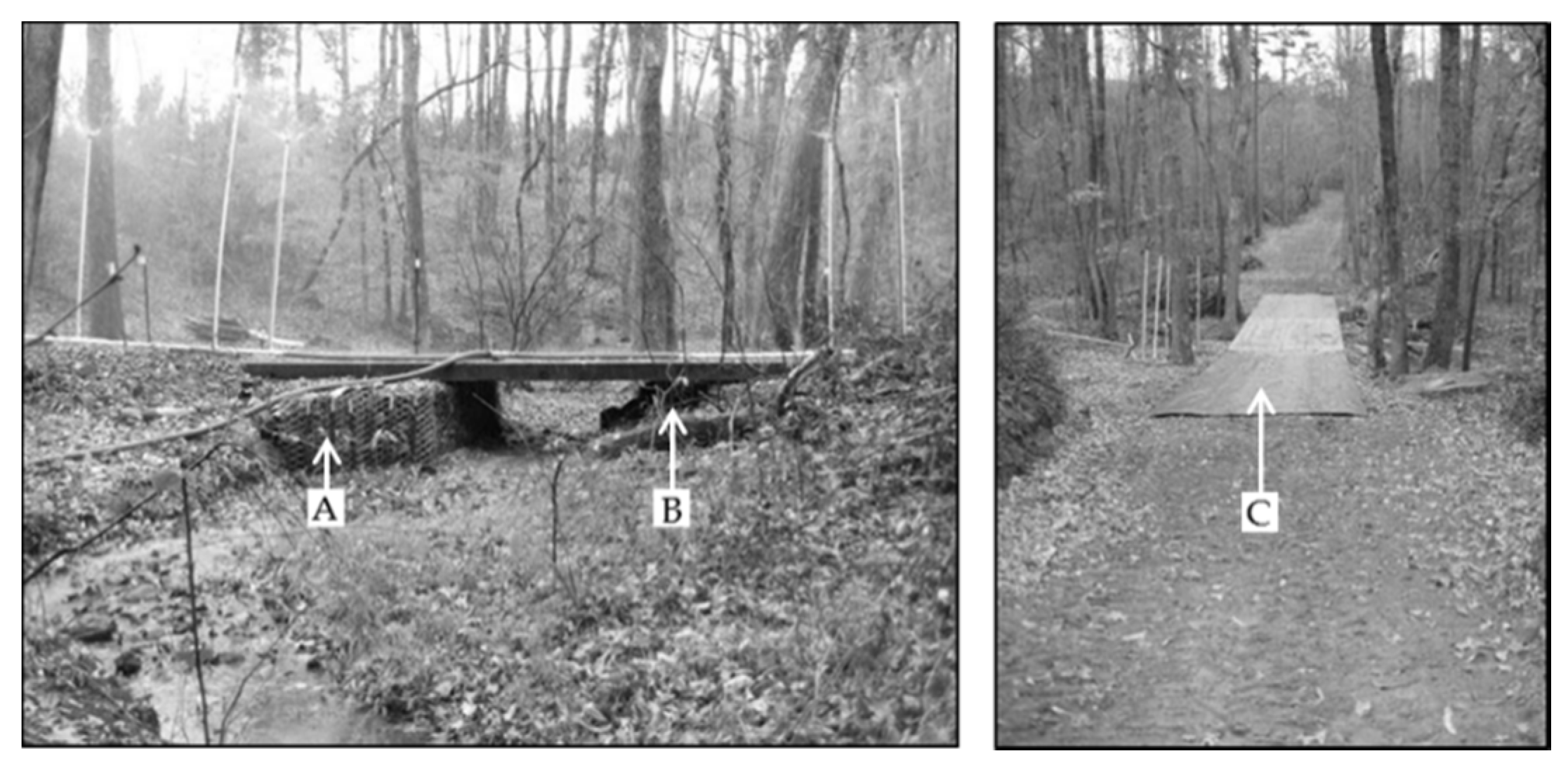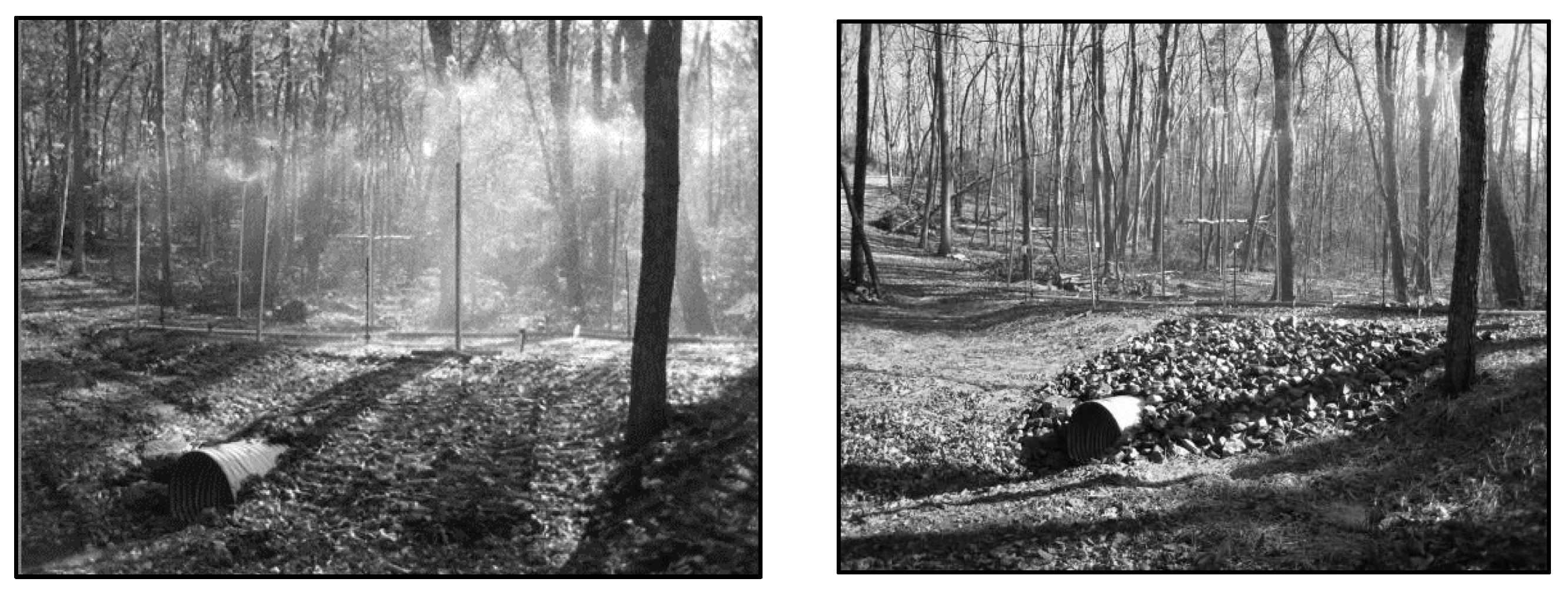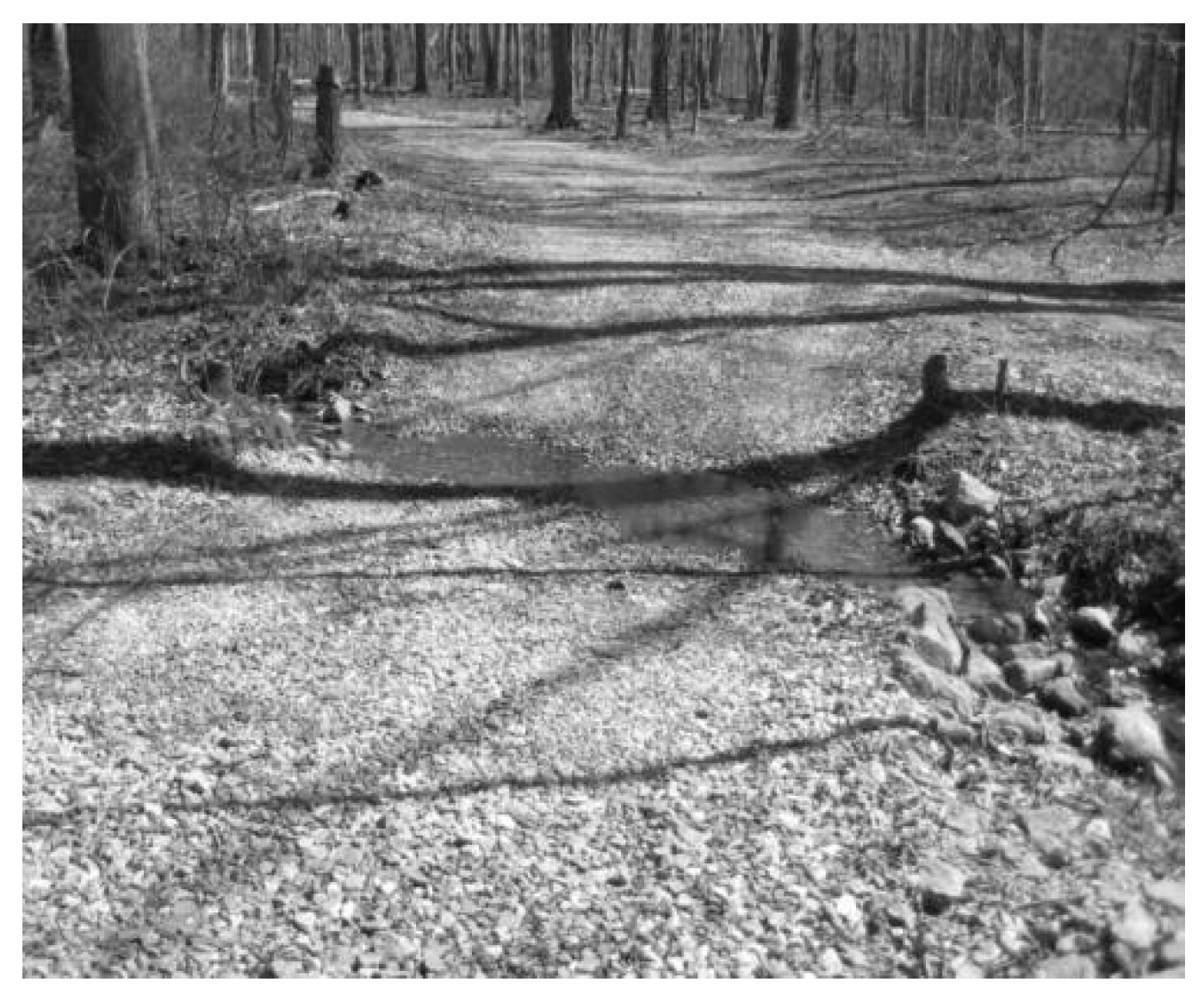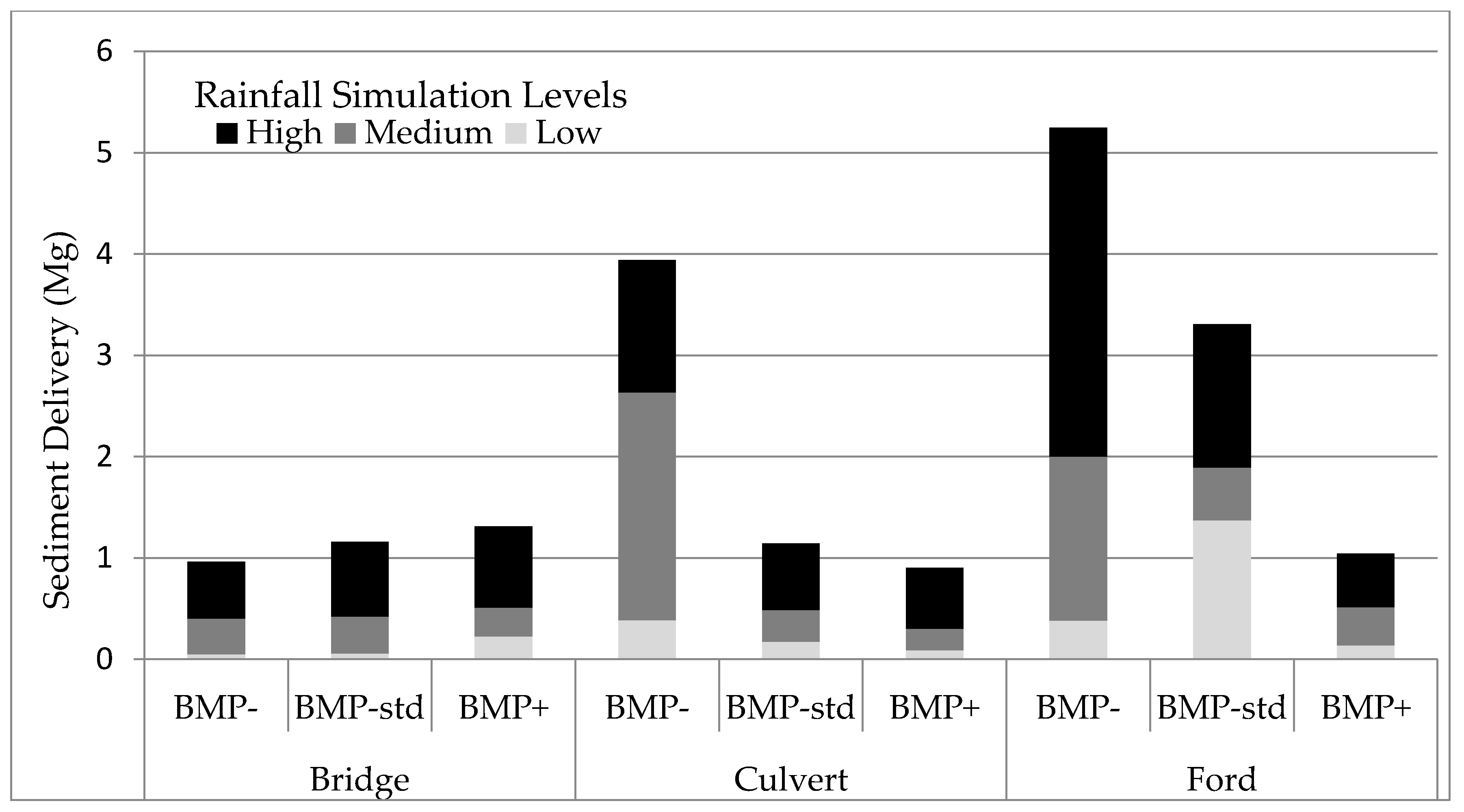1. Introduction
Forest operations generally have few long-term effects on water quality, but forest roads, skid trails, and stream crossings have long been areas of concern [
1,
2,
3,
4,
5]. Forest operations have been shown to alter stream water quality [
4]. Numerous research projects identified forest roads as a primary factor controlling sediment delivery from forest operations [
6,
7,
8,
9]. Trimble and Sartz [
10] conducted one of the earlier studies that evaluated how the proximity of forest roads to streams can increase sediment loading. Several of the early hydrologic watershed studies conducted on United States Forest Service Experimental Forests concentrated on the evaluation of forest roads and sediment [
11,
12,
13]. These evaluations have detected minimal long-lasting negative effects following timber harvesting alone, yet increases in sediment yield have been correlated with increased road building associated with timber harvesting [
14,
15].
The United States Environmental Protection Agency (EPA) assists states in implementing programs to reduce sediment from forest operations as a non-point source pollutant (NPSP). However, 2013 litigation in federal circuit courts, appeals courts, and the United States Supreme Court [
16] considered the possibility of treating forest roads as point sources of pollution, which would require federal permitting under the National Pollution Discharge Elimination System (NPDES). The U.S. Supreme Court decided that the EPA could continue with the current NPSP control via forestry Best Management Practices (BMPs), yet a recent review of forestry BMPs and sediment by Anderson and Lockaby [
17] identified gaps, including quantification of the effectiveness of BMPs and the optimization of BMP applications for sediment reduction. The gaps in BMP research, combined with the series of court rulings, have provided impetus for collaboration between forest managers and the regulatory community to identify and enhance methods of sediment reduction that are economically and environmentally effective [
18]. Loehle
et al. [
19] suggest that future forest water quality research should focus on BMP effectiveness and potential for future refinements.
BMPs are typically designed to minimize the factors that contribute to erosion or to direct sediment into areas where it can be deposited before entering a stream [
20,
21]. Following inception of the Federal Water Pollution Control Act of 1972, many states developed BMP guidelines for the protection of water quality, which have been shown to be effective [
21,
22,
23,
24,
25]. In 1997, state-implemented BMP effectiveness monitoring was found to be lacking; however, in 2010, many states had implemented effectiveness monitoring programs [
23,
26].
BMPs that maintain or increase the soil cover, increase interception of rainfall, and reduce soil particle detachment are typically effective erosion control measures [
27]. Such erosion control BMPs are epitomized by the retention of soil litter layers, re-establishment of vegetation, and application of soil cover such as mulch or slash [
28]. Erosion control measures, including straw mulch, slash [
24,
29,
30,
31], and gravel [
3,
32,
33,
34] have been found to reduce erosion potential. Edwards and Williard [
35] evaluated three studies of BMP efficiency for sediment reduction and found that the efficiency of BMPs as well as total sediment loads decreased as time after harvest increased.
The need to separate erosion from the road approach and the stream crossing was raised by Taylor
et al. [
36]. Thompson
et al. [
37] found that it was difficult to separate the effects of stream crossing road approaches from effects of the actual approaches while examining sediment produced from three Piedmont stream crossings (two bridges and one culvert) during the construction phase and after installation. Thompson
et al. [
37] concluded that the BMPs used on the approach were as important as the type of stream crossing used.
In Virginia, stream crossings have been identified as an area of concern regarding BMP effectiveness and implementation [
5]. Aust
et al. [
38] evaluated 23 stream crossings in the Piedmont of Virginia representing a range of crossing types and permanency. They concluded that culvert crossings and permanent crossings tended to result in lower downstream water quality, but also concluded that all crossing types could be adequate when the most applicable crossing structure is chosen for a given situation and appropriate BMPs are applied. This effectiveness of stream crossing BMPs was supported by Wear
et al. [
39], who evaluated the closure BMPs used for nine panel bridge skid trail stream crossings on harvest sites in the Piedmont of Virginia and found that slash or mulch could be effectively used to close stream crossings. Nolan
et al. [
40] evaluated BMP levels and erosion associated with 42 truck and skid trail crossings. Stream crossings having standard or enhanced levels of BMPs resulted in much lower erosion rates than crossings with substandard BMPs.
A 2009 survey found that 48% of loggers in the Piedmont region of Virginia had installed haul road stream crossings within the previous year [
41]. Bridges (wooden and steel panel) were the dominant crossing type (32%), followed by culverts (20%) and fords (8%). Costs of materials and installation for these crossings averaged $1,586 for culverts, $2,857 for wooden bridges, and $11,246 for steel bridges. No cost estimate was provided for fords in the Piedmont; however, in the Mountains the average ford cost was $975. Visser
et al. [
42] investigated stream crossing installation costs for four stream crossings in the Ridge and Valley physiographic region of Virginia. Costs were the least for an improved ford crossing at a 1.2 m-wide intermittent stream, followed by panel bridges crossing a 7.3 m-wide perennial stream, and a low water crossing constructed over a 24.4 m-wide perennial stream.
Haul road stream crossing structures (
i.e., bridges, culverts, fords,
etc.) each have different potential sediment contributions and costs [
43]. However, each crossing type may only be suitable in certain crossing locations and situations [
38]. Culverts are relatively simple to install, have moderate costs, and can be installed to bear heavy loads with simple designs. Disadvantages include disturbance of the natural streambed, modification of the stream cross-sectional area, and increased water velocity immediately below culverts [
44,
45]. Bridges can be expensive, but portable bridges can be used for multiple crossings over time. Fords have the advantage of relatively low cost if the streambed can bear heavy loads and handle most flood events [
41]. Disadvantages of fords include traffic limitations during high flows and in-stream sediment disturbance associated with traffic entering the stream channel.
Aust
et al. [
27] summarized problems associated with forest roads and stream crossings and concluded that many sediment problems are the result of insufficient planning, insufficient quality of BMPs, or inadequate quantities of BMPs. Application of erosion control measures on road surfaces [
33] and the use of forested stream buffers have been found to be effective for reducing erosion and stream sediment [
46,
47]. Stream crossings resulted in an increased potential for sedimentation due to the road crossing through the stream buffer at the stream crossing [
46]. Lane and Sheridan [
48] conducted a rainfall simulation experiment to quantify the principal sources of sediment from a culvert crossing (e.g., road surface, fill slope, and construction phase). They evaluated upstream and downstream total suspended solids (TSS) and turbidity values for stream crossings and found a two- to threefold increase in TSS and turbidity for a culvert crossing. Aust
et al. [
38] found that haul road stream crossings met or exceeded the state BMP standards on 78% of harvest tracts.
Recent litigation [
49] and surveys of BMP compliance [
5] have focused attention on forest stream crossings, which have the potential to contribute disproportionately large quantities of sediment to streams compared to their actual area. Despite concerns and the costs of implementing BMPs, there have been few studies investigating the direct impact of various stream crossing structures or stream crossing BMPs on sediment loads that separate the effects of the stream crossing from the effects of the road approach [
36].
This study was designed to quantify the sediment delivery and cost of stream crossing structures associated with different levels of BMPs. Specifically, this study: (1) estimated downstream sediment loading following simulated rain events on crossings with various levels of BMPs; (2) assessed the effectiveness of BMPs; and (3) determined the costs for crossing installation and additional BMPs.
4. Discussion
The rainfall simulation allowed for erosion from the stream crossing structure to be separated from erosion that would have originated upslope of the crossing on the road approach, fulfilling the need for separation of upslope road approaches and stream crossing structures described by Taylor
et al. [
36]. Brown
et al. [
33] used rainfall simulation in a companion study to evaluate BMP level and sediment delivery from the approaches on the same road as this study and concluded that gravelling either half or the total approach reduced sediment delivery from the approaches by two- to sevenfold. Although the sediment from stream crossings was observed without input from the upslope road approach, the areas within the stream crossing structure as defined by Lane and Sheridan [
48] were not distinguishable, and sediment that originated on the road surface could not be differentiated from sediment that originated on a fill slope or other area.
Initial construction of the bridge was costly due to increased labor required to prepare abutments and material costs of gabion baskets and geotextile used due to site specific characteristics. Removal of these items could reduce the material cost by $610 and likely reduce labor by several hours. The bridge material cost after removing gabion baskets is similar to costs reported by McKee
et al. [
41] for panel bridges in the Virginia Piedmont ($3152). However, the reported $246 installation cost is approximately 14% of the $1678 bridge installation cost recorded. This could be due to extra labor required for gabion basket installation as well as cost recording methods by logging contractors in the McKee
et al. [
41] survey.
A more likely reason for the differences in costs is because a majority of stream crossings reported by McKee
et al. [
41] were for temporary skidder bridges that are simply placed across the stream with a skidder. Our costs are more similar to those reported for permanent roads using a constructed stringer bridge ($10,147) and a three-panel wooden bridge ($5557) reported by Visser
et al. [
42]. Haul road crossings, even those that use panel bridges, often require more work on abutments and careful placement of panels, so additional costs are expected. Use of onsite equipment may reduce the recorded bridge installation cost if the logger only reported fuel and labor required to install the bridge rather than contractor rates, which would include ownership and transportation charges.
The construction phase of culvert with BMP− treatment required channel excavation, while the bridge crossing did not require excavation and the ford did not require excavation until the BMP+ treatment. Initial construction and the culvert BMP− treatment produced more sediment than the ford or bridge crossings during initial construction and BMP− treatments. These findings are similar to the negative downstream water quality impacts from culverts noted by Aust
et al. [
38] as well as the decreased downstream sediment from bridge construction compared to a culvert crossing [
37]. Geo-Web installation at the ford crossing required excavating the streambed and resulted in sediment delivery similar to the culvert crossing construction phase, which also required channel excavation. Total sediment production, including construction, was lowest for the bridge, due to the lack of disturbance to the stream channel. Channel excavation during installation of the culvert and upgrade of the ford crossing introduced a large pulse of sediment into the stream. In addition to sediment from channel excavation, increased water velocity downstream of a culvert can have stream scour impacts [
57] as well as issues for fish passage [
58].
The bridge crossing showed increases in sediment with increased BMP application. During experiments, visual observations of the stream channel under the bridge panels indicated a large sediment source which entered the stream under the centerline of the bridge behind the gabion baskets. The rock beneath the bridge panel or a soil pipe, which developed while removing stumps, could be responsible for the sediment traveling from the road surface under the bridge panel and through the gabion. This sediment source may be responsible for increased sediment as BMP levels increased. Sediment entering the channel beneath the bridge panel from the gabion was the only sediment entrance point, which was visually observable during the rainfall simulations.
The medium rainfall intensity simulation on the culvert BMP− treatment caused a small pool to develop between the fill slope and the abandoned road. During culvert rainfall simulations, the small soil barrier that was holding the pool was overtopped and allowed the small pool to drain directly into the channel, increasing the sediment loading at that point. Visual observations suggested that this increase in sediment concentration was only present during and immediately after the break in the soil barrier. Although the pool was an unforeseen problem with the initial construction and was not a designed portion of the treatment, similar instances may occur for other such crossings.
BMPs used in this study were effective at reducing sediment delivery and reinforce the findings of previous BMP studies [
21,
22,
23,
24,
39,
41]. For all three stream crossings, peak sediment delivery occurred later than the BMP− treatment with increased BMP levels, suggesting that they are effective at slowing or reducing overland flow. Altered overland flow could be due to increased surface roughness, depression storage, and changes in infiltration rates. There is evidence that BMPs are effective at reducing stream sedimentation on the culvert and ford crossings when the BMP−, BMP-std, and BMP+ treatments for all crossings were compared, while the mere use of a bridge stream crossing is an excellent BMP. Significant differences were found between the BMP− level and the BMP-std and BMP+ levels when all crossings were combined. The combined results suggest that the application of BMPs will reduce stream sedimentation, and the application of additional BMPs may further reduce stream sediment levels.
Reduction of in-stream sediment with increased BMPs is similar to findings of other studies for skid trail erosion [
24,
31] and haul road stream crossing approaches [
33,
34]. The BMP+ treatment in this study was designed to minimize bare soil and to armor as much disturbed soil as practically possible. Soil disturbance was found to alter the effectiveness of stream crossing approach BMPs [
33] when the equipment used for the road surfacing BMP treatment left large ruts in the roadway due to muddy conditions. In these cases, BMPs were effective unless there was substantial soil disturbance in an area that could drain to the stream channel. A lack of water control structures on a stream approach may increase the volume of water flowing onto and over a crossing structure, which could increase soil erosion and possibly sedimentation.
Increased levels of BMPs resulted in decreased sediment delivery on the culvert and ford crossings, with the BMP+ treatment resulting in the greatest sediment reduction efficiency. The BMP-std treatment for the ford resulted in the best BMP cost-effectiveness ratio ($124 Mg−1 of sediment reduced), followed by the ford BMP+ treatment ($410 Mg−1 of sediment reduced), and the culvert BMP-std treatment ($972 Mg−1 of sediment reduced). The bridge BMP− treatment resulted in a cost-effectiveness ($1,221 Mg−1 of sediment reduced) similar to that of the culvert BMP+ treatment ($1,016 Mg−1 of sediment reduced), suggesting that the bridge crossing type may be an appropriate BMP for crossing locations in which a bridge can be properly installed. For all three crossings, lower levels of BMPs resulted in decreased costs when compared to BMP+ treatments; however, the level of sediment delivery from the BMP- treatment may not be acceptable.
Due to the progression of rainfall simulations from the lowest level of BMP implementation to the highest, it is possible that erosion rates could have decreased due to time since disturbance as well as increased erosion protection measures. In addition, these experiments were designed to test BMP treatments immediately following construction activities. Increased time since disturbance would likely result in increased vegetative and organic matter cover through grass germination and leaf fall from the surrounding hardwood forest. This increased cover, coupled with increased stability, will likely alter erosion rates into the future.
5. Conclusions
Channel disturbances during construction increased downstream sediment concentrations, and the only stream crossing treatment that consistently minimized in-stream disturbances was the bridge treatment. The bridge produced the least stream sediment during construction, but it was the most expensive treatment considered in this study. However, the cost per use of a bridge is reduced when portable temporary bridges are used. The bridge treatment alone (BMP−) was still a better BMP option than the other stream crossings tested for minimizing in-stream sediment concentrations.
Increased levels of BMPs were associated with decreased stream sediment for ford and culvert stream crossings. However, in some cases, increased costs associated with higher levels of BMPs for the crossings were growing at a greater rate than the sediment reduction. In situations where funds are limited, it might be more beneficial to target the larger sediment problems first. For example, BMPs applied to the culvert were more beneficial than those applied to the bridge.
Each crossing type has unique advantages and disadvantages, and downstream sediment can be acceptable below all types of crossings as long as appropriate location and erosion control measures are utilized. Further research that can identify which portions of a crossing structure pose the greatest risk for erosion could further improve cost-effectiveness of BMPs by focusing efforts on areas with greatest risk. Individual site characteristics may warrant installation of one crossing over another. In these cases, landowners and managers must determine which crossing best fits their needs and budgets and then apply appropriate BMPs.










